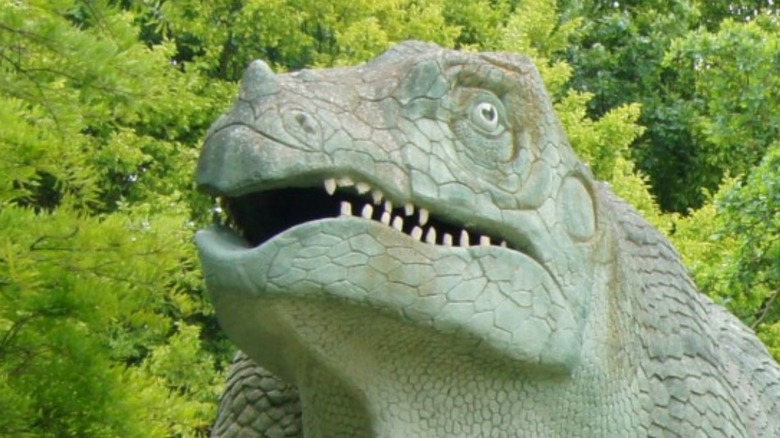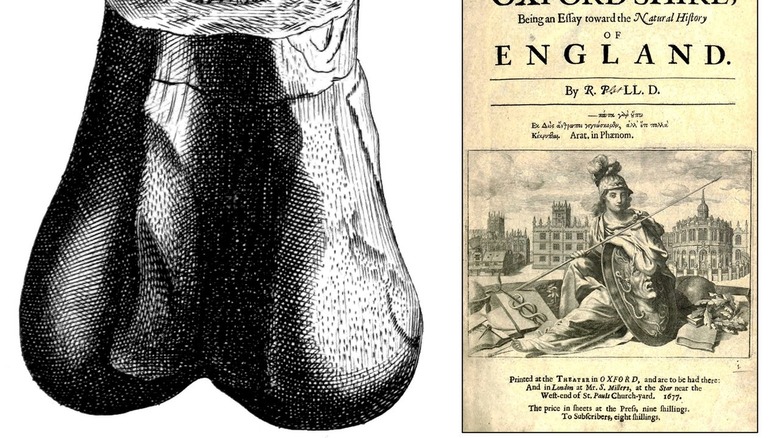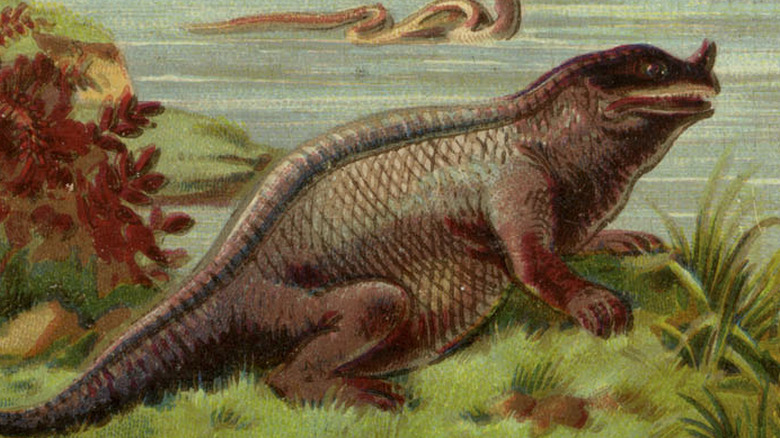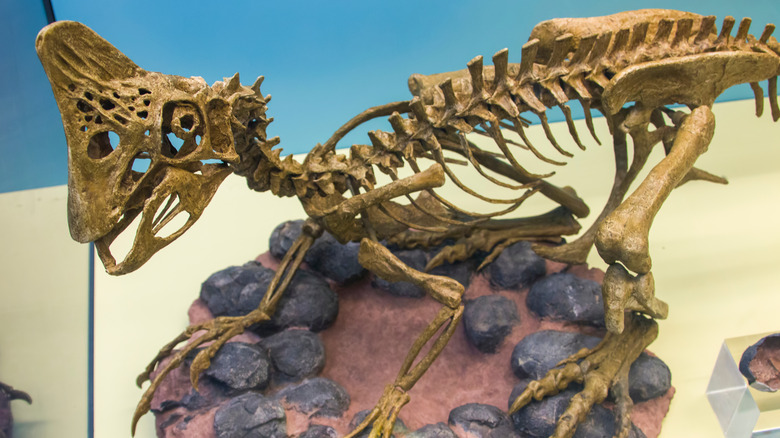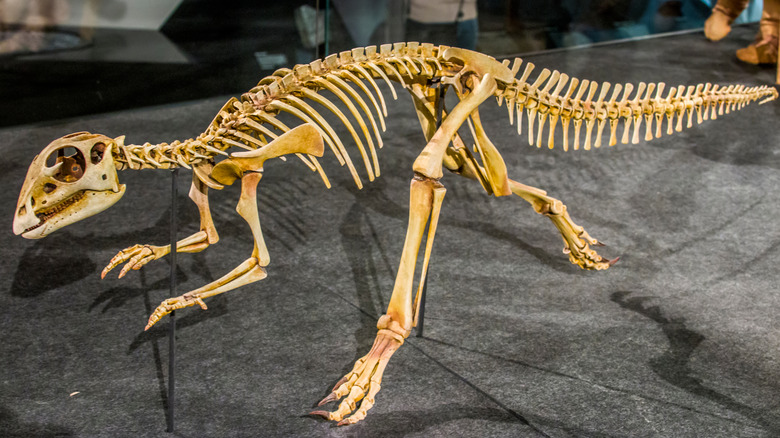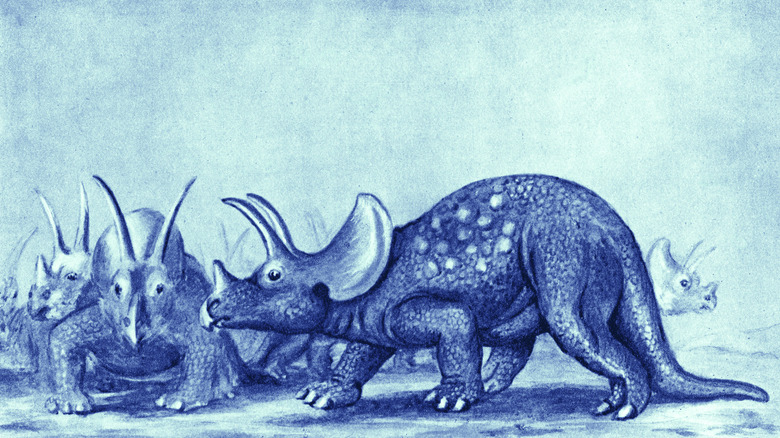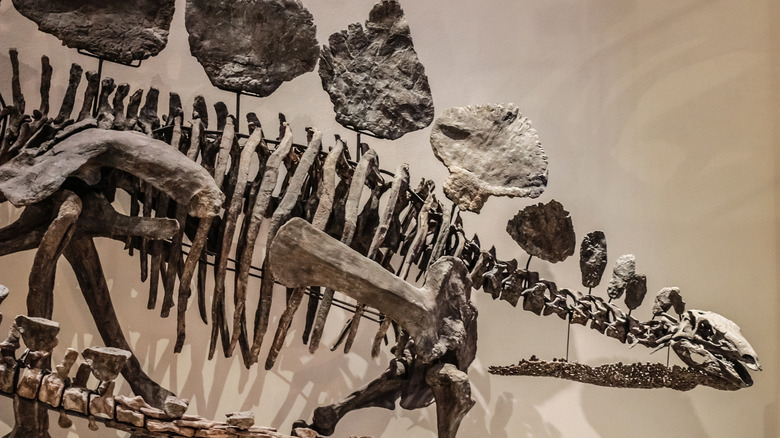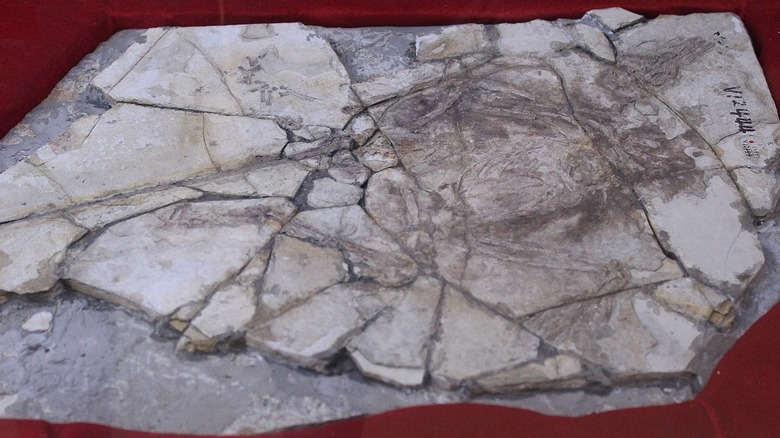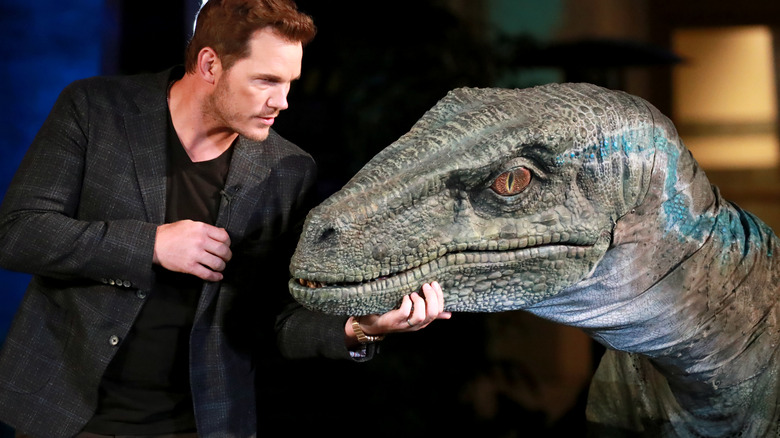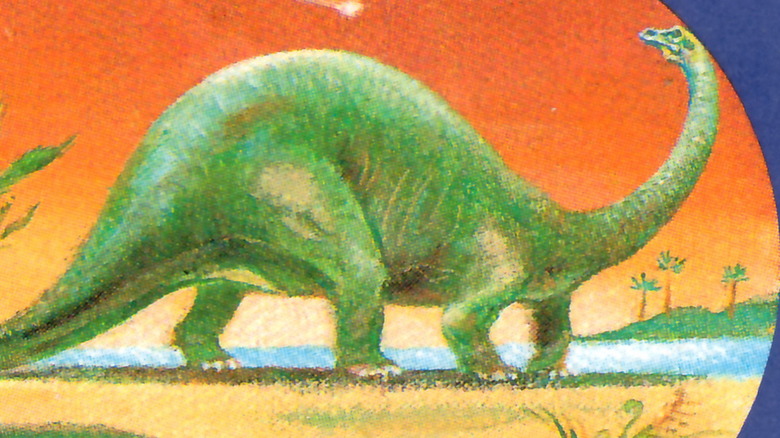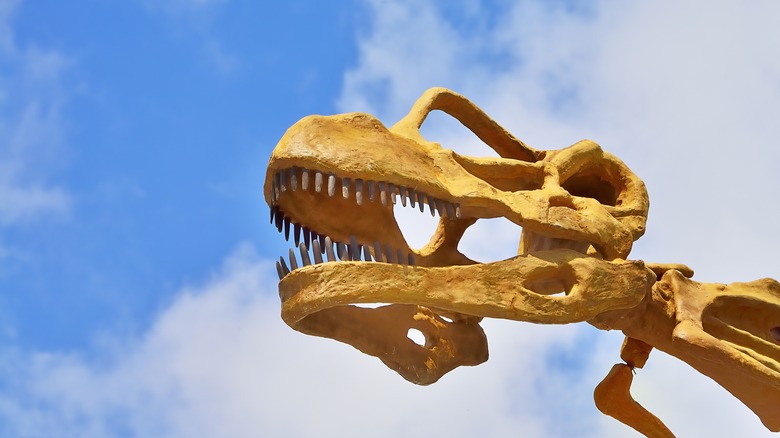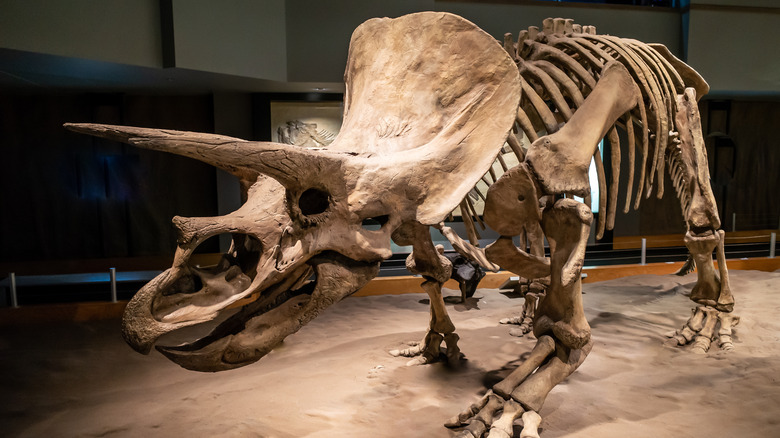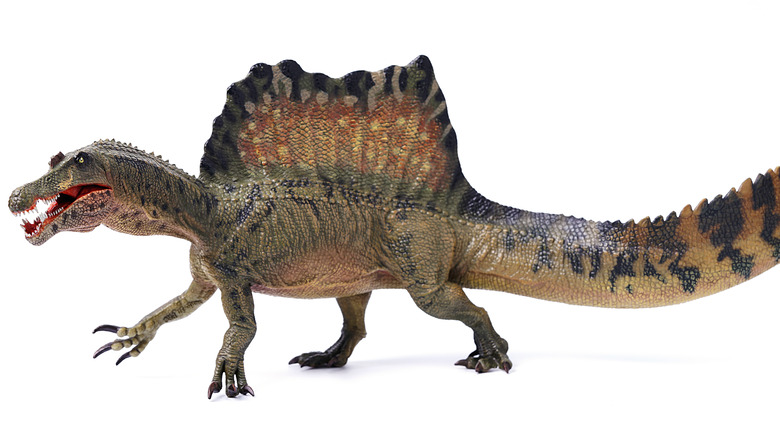Things Science Got Wrong About The Dinosaurs
Some people mistakenly believe that science is all about declaring absolute truths and being correct 100% of the time. That's wrong, though: The pursuit of science means collecting as much evidence as possible and then making reasonable, intelligent observations about the things around us. And when your evidence is incomplete and millions of years old, it's not surprising for you to make a few wrong turns along the way.
Take the dinosaurs, for example. Despite the fact that there are countless interpretations of these "terrible lizards" in illustrations, films, and other works of art, we've obviously never seen or heard what a living, breathing non-avian dinosaur looks like. Heck, it hasn't even been two centuries since someone came up with the idea to call them "dinosaurs" in the first place. Here are a few noteworthy instances in which science was off base (or in some cases, way off base) about dinosaurs.
Naming the first dinosaur ever found after human testicles
In the latter half of the 17th century, the debate about fossils was heating up, mostly because scientists back then weren't completely sure about what they were looking at, exactly. Robert Plot, an Oxford chemistry professor and museum keeper, offered an answer in 1677 when he published his book "Natural History of Oxfordshire": giant humans (via the Oxford University Museum of Natural History).
When workers unearthed a strange-looking object from an English quarry, Plot correctly deduced that it was a petrified thigh bone fragment. However, because it didn't match any creature known to science at the time, Plot proposed that it came from a man or woman "of proportionable Stature." He included an illustration of the fossil in his book, which today's experts recognize as the first published dinosaur bone image.
Fast-forward to 1763, when a physician named Richard Brookes took a look at the illustration in Plot's book and decided, "Hey, those totally look like testicles" (presumably while giggling). Proudly applying the binomial naming system that botanist Carl Linnaeus began consistently using a decade earlier, Brookes labeled it Scrotum humanum when he included the artwork in his own book. An Oxford academic and paleontologist named William Buckland gave it the far more dignified name Megalosaurus in his 1824 article. Unsurprisingly, despite the fact that Brookes published his suggestion first, the International Commission on Zoological Nomenclature ruled that Buckland's idea was a better fit.
Putting a dinosaur's thumb on its nose
Again, it's important to understand that in the early 19th century, people were only beginning to figure out what dinosaurs were. That's how the world ended up with a Mesozoic-inspired milestone: the inaccurate dinosaur statues in London's Crystal Palace. Built in the 1850s, the sculptures featured three different dinosaurs, built based on the limited data available at the time. Thus, the carnivorous, bipedal Megalosaurus became a four-legged creature resembling a Komodo dragon, the armored Hylaeosaurus became a spike-backed lizard, and the pointy-thumbed Iguanodon was represented by two massive iguana-like animals, each sporting a small nasal horn.
In an interview with the Natural History Museum, researcher Susie Maidment explained how paleontologist Gideon Mantell, whose wife Mary Ann is widely recognized as the discoverer of the first Iguanodon fossils, ended up incorrectly reconstructing the dinosaur based on partial fossils: "They found the thumb spike and stuck it on the end of the nose, a bit like a rhinoceros."
Nearly three decades later, in 1878, a coal mine in Belgium yielded a big surprise: 30 almost-complete Iguanodon fossils (via the Royal Belgian Institute of Natural Sciences). This discovery helped bring dinosaur experts closer to anatomical accuracy for Iguanodon. However, while they did manage to assemble Iguanodon correctly, they mistakenly assumed it stood like a tail-dragging kangaroo. This was the norm until 1980, when new research revealed Iguanodon's true stiff-tailed, four-legged posture (via Discover Magazine). Hey, at least the Crystal Palace statues got something right.
Accusing a dinosaur of stealing and eating ... its own eggs
In 1923, paleontologists from the American Museum of Natural History went on an expedition to Mongolia. Under the hot sun of the Gobi Desert, they stumbled upon an interesting find: eggs that apparently belonged to Protoceratops, a small, frilled dinosaur ... and a previously undescribed dinosaur's skull on top of one of the nests.
According to Smithsonian Magazine, the researchers assessed the preserved scene and figured that the skull belonged to a dinosaur that was likely killed for trying to steal some eggs. It seemed like a reasonable assumption: After all, the toothless dinosaur's curved jaws looked like they were made for cracking eggs open. A year later, paleontologist Henry Fairfield Osborn gave it the rather unflattering name Oviraptor, meaning "egg thief."
Seventy years later, in 1993, the arid region revealed another puzzle piece in the story of this Mesozoic mistake. Due to the discovery of similar-looking eggs with oviraptorid embryos inside them, experts realized that the "egg thief" wasn't actually stealing eggs but guarding its own. Furthermore, according to the University of California Museum of Paleontology, Oviraptor's powerful maw wasn't really for breaking eggshells but for crushing tough food. Talk about having egg on your face.
Turning a grounded dinosaur into a tree-dweller (and frequently mistranslating its name)
As Mark A. Norell wrote in his book "The World of Dinosaurs," workers on the Isle of Wight in England unearthed the first known Hypsilophodon remains midway through the 19th century. This means that this small, bipedal dinosaur was among the early discoveries in the field. Unfortunately, this also means that scientists got quite a few things wrong about it — and oddly enough, the list includes what Hypsilophodon's name really means.
Initially, experts thought that the Hypsilophodon fossils belonged to a young Iguanodon (via Prehistoric Wildlife). This changed in 1868, when biologist Thomas Henry Huxley realized that it was actually a different dinosaur after studying a new specimen. A year later, he formally proposed the name Hypsilophodon, due to the fact that its teeth looked a lot like those belonging to a lizard called Hypsilophus (which is now synonymous with iguanas). Incidentally, Hypsilophodon's name actually means something else when translated in Greek: "high-ridged tooth." Due to the nature of the binomial naming system, many who are unaware of the history of the dinosaur's discovery often end up mistranslating its name.
At one point, scientists thought Hypsilophodon had armored plates running down its back. They also thought that it walked on four legs and lived in trees like today's tree-kangaroos, a misconception that was later debunked by paleontologists like Peter M. Galton.
Portraying dinosaurs as sluggish, cold-blooded dimwits
The aforementioned Crystal Palace statues prove just how hard it was to figure out what certain dinosaurs looked like based on limited fossil evidence. Despite this, the discovery of more dinosaur remains in the 19th and 20th centuries further stoked the curiosity of academics and the general public. The quest to find out what these prehistoric animals looked like when they were alive popularized a genre of creative and intelligent guesswork: paleoart (via National Geographic).
As paleontologists continued to study dinosaurs, paleoartists like Charles M. Knight used evidence and imagination to create visual representations of a lost world. Interestingly, a common trend in these early works was the depiction of dinosaurs as lethargic, tail-dragging, unintelligent creatures that time had a good reason to forget. As The Conversation put it: "Viewed as evolutionary failures, dinosaurs were bloated sluggish beasts in primordial swamps." Take Tyrannosaurus rex, for example: Up until the late 20th century, various films and artwork featured the theropod with downward-facing "bunny hands" and a tail that functioned as a third leg, like a tripod (via the Natural History Museum).
Paleoartists weren't solely responsible for their inaccurate dinosaur portrayals, though. In fact, scientists couldn't even decide whether dinosaurs were warm-blooded or cold-blooded (via Discover Magazine). It was the 1964 discovery of Deinonychus, an agile, sickle-toed carnivore, that helped science realize that the answer is, in fact, a bit less straightforward.
Thinking a dinosaur had two brains
Modern science says that the connection between brain size and intelligence isn't as clear-cut as it seems. Sperm whales, for instance, have the biggest brains in the world (via the American Museum of Natural History), but they aren't necessarily the smartest animals around. Still, this apparent link is part of why Stegosaurus suffered from both bad PR and a persistent myth over the course of many years.
Based on the imprint left in its skull, experts estimated that Stegosaurus had a brain the size of a walnut (though "the size and shape of a bent hotdog" would be more accurate, as per dinosaur expert Kenneth Carpenter). It had one of the lowest dinosaur brain-to-body ratios, making it easy for pop culture to turn it into the poster boy of Mesozoic moronity. Scientists even thought that Stegosaurus didn't have enough brainpower in its skull to function properly. Thus, when they noticed that its spinal column had a cavity in the region above its rear legs, they figured there was enough space there for a second brain.
However, due to lack of fossil evidence and the simple fact that animals don't need to be super-smart just to survive, the idea of Stegosaurus having a second brain is just plain false. According to Smithsonian Magazine, it's more likely that the hip cavity could have contained a bundle of nerves (to help it control its appendages) or a glycogen body like today's birds (for energy storage).
Getting fooled by the Piltdown man of dinosaurs
The Piltdown man is one of paleontology's most powerful cautionary tales: proof that with sufficient skill, one can create a fossil composite capable of fooling the most eagle-eyed experts. Nearly 90 years later, another story of a fake "missing link" emerged. This time, however, instead of being inserted into the narrative of human evolution, it was an attempt to show how birds descended from dinosaurs — and somehow, it successfully bamboozled one of the world's most trusted media institutions.
In 1999, National Geographic introduced the world to Archaeoraptor, a fossil from China that sported feathered arms and a dinosaur tail (via Scientific American). Experts noted a few problematic things about this unveiling: For starters, you're not supposed to just name a new dinosaur without scientific consensus. Furthermore, the paper describing Archaeoraptor never appeared in a peer-reviewed journal. Eventually, the truth came out: Archaeoraptor was a forgery, a composite of fragments from different animals crafted by farmers seeking to make a quick (and illegal) buck from non-Chinese fossil hunters (via The Guardian).
Aside from embarrassing everyone involved in the fiasco, Archeoraptor also fueled the arguments of people who strongly disagreed with the idea that birds evolved from dinosaurs. Recent years have seen new, verified evidence of feathered dinosaurs, though. In fact, tests revealed that part of Archaeoraptor belonged to an actual, previously unknown feathered dinosaur, Microraptor. Thus, Archaeoraptor did end up reinforcing the feathered dinosaur theory — just not in the way it was intended.
Portraying feathered dinosaurs as scaled crocodilians
From 1914's "Brute Force" to 1993's "Jurassic Park," films reinforced the notion that all dinosaurs were scaly reptilians. Velociraptor is perhaps the most famous example: Portrayed as cold, calculating, and crocodilian, the clawed predator is easily the breakout star of the "Jurassic Park" films. In reality, though, the franchise's Velociraptors were closer in size to Deinonychus than the actual turkey-sized Velociraptors (via The Guardian). More importantly, just like other members of the meat-eating dinosaur group called dromaeosaurs, Velociraptors had feathers.
Thomas Henry Huxley was one of the early proponents of the "feathered dinosaurs" idea. He observed significant structural similarities between the tiny theropod Compsognathus and the bird-like dinosaur Archaeopteryx (classified as a prehistoric bird at the time) and published them in 1868. Given the limited evidence of feathered dinosaurs available at the time (via Smithsonian Magazine), many scientists didn't support this idea. The debate raged on until 1996, when the discovery of Sinosauropteryx, a dinosaur fossil with feather imprints, settled it once and for all: Indeed, there were feathered dinosaurs — and birds came from them.
However, not all dinosaurs had feathers. While different groups of dinosaurs may have sported feathers or proto-feathers, most confirmed feathered dinosaurs were maniraptorans, long-armed theropods with unique bird-like features in their skeletons. Taxonomically speaking, birds are maniraptorans, too (via the University of California Museum of Paleontology). In other words, until new fossil evidence pops up that says otherwise, birds are living dinosaurs.
Inventing a new dinosaur species because of someone's fragile ego
Competition can bring out both the best and worst in humanity. The late 19th century rivalry between Othniel Charles Marsh and Edward Drinker Cope — a bitter feud historians call the Bone Wars – demonstrates this clearly. For 15 years, the two men strove to outdo each other and prove who was the better paleontologist. They discovered 136 new dinosaur species combined but also ruined their reputations and finances (via the Museum of Idaho). Another interesting outcome of this dinosaur rush? A case of mistaken Mesozoic identity.
In 1877, Marsh found the fossilized remains of a sauropod (via NPR). Though it was missing its skull, Marsh realized that he was looking at a previously unknown species and named it Apatosaurus. Two years later, his team came across a more complete Apatosaurus specimen, this time with its skull. In his haste to one-up Cope, Marsh decided that it was an entirely different dinosaur and gave it the name Brontosaurus. However, when experts took a more in-depth look at his research in 1903, they decided that Marsh's Apatosaurus and Brontosaurus were actually the same species, though the idea of the Brontosaurus remained in the public consciousness for decades afterward.
In 2015, a group of scientists suggested reviving the Brontosaurus genus, based on their observations that the two skeletons actually do have significant differences (via LiveScience). Time will tell, however, if this will catch on with the rest of the scientific community.
Mistakenly crowning the biggest dinosaur (again and again and again)
Humans love superlatives: best, worst, brightest, dumbest, longest, shortest, and so on. And when it comes to dinosaurs, "biggest" ranks high on the list. However, experts estimate that we've only discovered about a third of all the Mesozoic dinosaur species (via National Geographic). Hence, it's not that surprising that science has made — and will probably continue to make — contradicting claims about which dinosaur was the biggest.
Among the most well-known examples is Ultrasaurus, a long-necked dinosaur whose existence started getting media coverage in 1979 (according to SV-POW!, a site run by three paleontologists). It turned out to be a chimera of multiple sauropods in the same fossil bed (via National Geographic). And then there's Dreadnoughtus, noteworthy for the fact that over 70% of its bones were discovered — which means unlike other sauropods, its size in life could be calculated with confidence (via ScienceDaily). Nearly a year after its discovery, though, scientists realized that based on available data, it probably only had two-thirds of the mass they originally thought it had.
Out of all known dinosaurs, either Argentinosaurus or Patagotitan could be the biggest, depending on the definition of "biggest." While some scientists say the former was more massive (via Syfy Wire), others estimate that the latter could be the largest based on incomplete fossil evidence (via Phys.org).
Almost merging two separate three-horned dinosaurs
Near the end of the Bone Wars, Othniel Charles Marsh described two of the largest and most well-known ceratopsians (horned dinosaurs) of all: Triceratops and Torosaurus (via Smithsonian Magazine). Both had three horns and massive frills, though Torosaurus' frill was longer. For more than 100 years, experts generally agreed with Marsh's assessment that the two Cretaceous plant-eaters had enough morphological differences to warrant being classified as separate species.
However, paleontologists John Scannella and Jack Horner offered a controversial take in 2010: Torosaurus was actually the adult form of Triceratops. After looking at numerous specimens, the two reportedly saw hints of the bone undergoing change in Triceratops skulls, as well as "heavily remodeled" tissues in Torosaurus remains (suggesting they were all adults). An article on Science Daily quoted Scannella as saying that in the three years that he and Horner had spent trying to disprove their hypothesis, each part of the process "only supported the idea further." Subsequent research cast doubt on that theory, however, and to this day, Triceratops and Torosaurus are still officially classified as different animals.
However, Triceratops's popularity was more than enough to grab the media's attention and cause an online ruckus when Scannella and Horner's findings came out. Unsurprisingly, the public did not react warmly to the possibility that one of the most iconic dinosaurs didn't actually exist (via Smithsonian Magazine). Nevertheless, since Marsh described Triceratops two years before describing Torosaurus, the latter name would have gotten the boot if they were the same.
Getting a dinosaur completely wrong for about a century
Few dinosaurs have gone through as many bizarre and dramatic changes in their scientific interpretation as the sail-backed Spinosaurus, the largest known meat-eating dinosaur.
German paleontologist Ernst Stromer described the species in 1915, based on a partial skeleton discovered three years earlier. According to the Natural History Museum, those same remains — the only known Spinosaurus fossils at the time — were destroyed during World War II. For decades, paleontologists could only study Stromer's surviving sketches, which depicted the animal as a terrestrial carnivore with a bulky build, a kangaroo-like posture, and a carnosaur-like head.
It took nearly a century after Stromer's original discovery before paleontologists found a relatively complete Spinosaurus specimen, which enabled them to rethink the way the theropod had been portrayed for decades (via the Carnegie Museum of Natural History). Modern-day findings have revealed that it was likely semi-aquatic and a fish-eater, with a long, crocodilian snout and a thick, paddle-like tail that it probably used to propel itself through rivers as it searched for prey.
